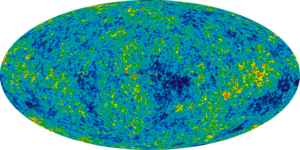 |
|
This detailed, all-sky picture of the infant universe was
created from seven years of WMAP data. The image reveals
temperature fluctuations in the cosmic gas (shown by variations
in colour) just 400,000 years after the Big Bang itself. These
are weak sound waves which later grew to become the galaxies we
see today. The signal from our Galaxy was subtracted using the
multi-frequency data. This image shows a temperature range of
±200 µK.
Credit: NASA / WMAP Science Team
|
|  |
WMAP is a NASA satellite mission which was launched in 2001 into an orbit near
the second Lagrange point of the Earth-Sun system. (This is beyond the Moon’s
orbit in the diametrically opposed direction to the Sun, as seen from Earth.)
The WMAP satellite has mapped the nearly uniform Cosmic Microwave Background
(CMB) radiation across the whole sky, making an image of tiny variations in
temperature which reflect small density fluctuations. These structures are seen
when the Universe as a whole was only 400,000 years old, long before any stars
or galaxies had formed.
The latest analysis of the WMAP data concluded, in a paper led by Komatsu, that the Universe:
- is within 1 percent of 13.75 billion years old;
- consists of 22.7 percent dark matter, 72.8 percent dark energy, and only 4.6 percent “ordinary” matter;
- seems to have undergone a period of “inflation” in the first trillionth of a trillionth of a trillionth of a second of its existence, just as many theorists have been predicting;
- has a flat geometry, to within 0.6 percent.
So precise are these findings that WMAP’s version of the Universe is now commonly known as the Standard Cosmological Model.
Charles Bennett was the Principal Investigator of this mission and Eiichiro
Komatsu’s principal role in the team was to help understand the physical
implications of the observed structure. In 2010, WMAP finally stopped taking
data, but in summer 2009 a successor mission was launched: The Planck Surveyor
satellite mission measures the CMB temperature fluctuations with even higher
accuracy than WMAP. The Max Planck Institute for Astrophysics developed
important software components for Planck and is heavily involved in the
scientific interpretation of the mission data.
Links:
 Announcement by the Gruber Foundation Announcement by the Gruber Foundation
Original publication:
 Seven-Year Wilkinson Microwave Anisotropy Probe (WMAP) Observations: Cosmological Interpretation Seven-Year Wilkinson Microwave Anisotropy Probe (WMAP) Observations: Cosmological Interpretation
Komatsu, E., et.al., 2011, ApJS, 192, 18
Contact:
Dr. Hannelore Hämmerle
Press Officer
Max Planck Institute for Astrophysics, Garching
Tel. +49 89 30000-3980
E-mail:  hhaemmerle@mpa-garching.mpg.de hhaemmerle@mpa-garching.mpg.de
For more information on the Gruber Prize please contact
A. Sarah Hreha
Tel: +1 (212) 247-8484.
E-mail:  media@gruberprizes.org media@gruberprizes.org
|
